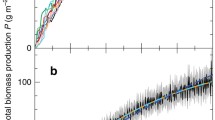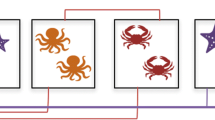Abstract
We manipulated the diversity of top predators in a three trophic level marine food web. The food web included four top benthic marine fish predators (black goby, rock goby, sea scorpion and shore rockling), an intermediate trophic level of small fish, and a lower trophic level of benthic invertebrates. We kept predator density constant and monitored the response of the lower trophic levels. As top predator diversity increased, secondary production increased. We also observed that in the presence of the manipulated fish predators, the density of small gobiid fish (intermediate consumers) was suppressed, releasing certain groups of benthic invertebrates (caprellid amphipods, copepods, nematodes and spirorbid worms) from heavy intermediate predation pressure. We attribute the mechanism responsible for this trophic cascade to a trait-mediated indirect interaction, with the small gobiid fish changing their use of space in response to altered predator diversity. In the absence of top fish predators, a full-blown trophic cascade occurs. Therefore the diversity of predators reduces the likelihood of trophic cascades occurring and hence provides insurance against the loss of an important ecosystem function (i.e. secondary production).






Similar content being viewed by others
References
Balvanera P, Pfisterer AB, Buchmann N, He JS, Nakashizuka T, Raffaelli D, Schmid B (2006) Quantifying the evidence for biodiversity effects on ecosystem functioning and services. Ecol Lett 9:1146–1156
Borer ET, Seabloom EW, Shurin JB, Anderson KE, Blanchette CA, Broitman B, Cooper SD, Halpern BS (2005) What determines the strength of a trophic cascade? Ecology 86:528–537
Bruno JF, O’Connor MI (2005) Cascading effects of predator diversity and omnivory in a marine food web. Ecol Lett 8:1048–1056
Byrnes J, Stachowicz JJ, Hultgren KM, Hughes AR, Olyarnik SV, Thornber CS (2006) Predator diversity strengthens trophic cascades in kelp forests by modifying herbivore behaviour. Ecol Lett 9:61–71
Byrnes JE, Reynolds PL, Stachowicz JJ (2007) Invasions and extinctions reshape coastal marine food webs. PLoS ONE 2:e295
Cardinale BJ, Harvey CT, Gross K, Ives AR (2003) Biodiversity and biocontrol: emergent impacts of a multi-enemy assemblage on pest suppression and crop yield in an agroecosystem. Ecol Lett 6:857–865
Cardinale BJ, Srivastava DS, Duffy JE, Wright JP, Downing AL, Sankaran M, Jouseau C (2006) Effects of biodiversity on the functioning of trophic groups and ecosystems. Nature 443:989–992
Cohen JE, Pimm SL, Yodzis P, Saldana J (1993) Body sizes of animal predators and animal prey in food webs. J Anim Ecol 62:67–78
Costello MJ (1992) Abundance and spatial overlap of gobies (Gobiidae) in Lough-Hyne, Ireland. Environ Biol Fishes 33:239–248
Costello MJ, Myers AA (1996) Turnover of transient species as a contributor to the richness of a stable amphipod (Crustacea) fauna in a sea inlet. J Exp Mar Biol Ecol 202:49–62
Crumrine PW, Crowley PH (2003) Partitioning components of risk reduction in a dragonfly-fish intraguild predation system. Ecology 84:1588–1597
DeAngelis DL (1980) Energy-flow, nutrient cycling, and ecosystem resilience. Ecology 61:764–771
Duffy JE, Richardson JP, Canuel EA (2003) Grazer diversity effects on ecosystem functioning in seagrass beds. Ecol Lett 6:637–645
Duffy JE, Carinale BJ, France KE, McIntyre PB, Thebault E, Loreau M (2007) The functional role of biodiversity in ecosystems: incorporating trophic complexity. Ecol Lett 10:522–538
Eklov P, VanKooten T (2001) Facilitation among piscivorous predators: effects of prey habitat use. Ecology 82:2486–2494
Finke DL, Denno RF (2005) Predator diversity and the functioning of ecosystems: the role of intraguild predation in dampening trophic cascades. Ecol Lett 8:1299–1306
France KE, Duffy JE (2006) Diversity and dispersal interactively affect predictability of ecosystem function. Nature 441:1139–1143
Gamfeldt L, Hillebrand H, Jonsson PR (2005) Species richness changes across two trophic levels simultaneously affect prey and consumer biomass. Ecol Lett 8:696–703
Gascuel D (2005) The trophic-level based model: a theoretical approach of fishing effects on marine ecosystems. Ecol Modell 189:315–332
Gobin JF, Warwick RM (2006) Geographical variation in species diversity: a comparison of marine polychaetes and nematodes. J Exp Mar Biol Ecol 330:234–244
Griffen BD (2006) Detecting emergent effects of multiple predator species. Oecologia 148:702–709
Guidetti P (2007) Predator diversity and density affect levels of predation upon strongly interactive species in temperate rocky reefs. Oecologia 154:513–520
Jennings S, Pinnegar JK, Polunin NVC, Boon TW (2001) Weak cross-species relationships between body size and trophic level belie powerful size-based trophic structuring in fish communities. J Anim Ecol 70:934–944
Jolliffe PA (2000) The replacement series. J Ecol 88:371–385
Kneib RT (1988) Testing for indirect effects of predation in an intertidal soft-bottom community. Ecology 69:1795–1805
Losey JE, Denno RF (1998) Positive predator–predator interactions: enhanced predation rates and synergistic suppression of aphid populations. Ecology 79:2143–2152
Martinez ND (1993) Effect of scale on food web structure. Science 260:242–243
Nilsson E, Hertonsson P, Stenberg M, Brodersen J, Olsson K, Stenroth P, Lakowitz T, Bronmark C, Nystrom P, McIntosh AR (2006) Facilitation and interference among three predators affect their consumption of a stream-dwelling mayfly. Freshwater Biol 51:1507–1514
Okuyama T, Bolker BM (2007) On quantitative measures of indirect interactions. Ecol Lett 10:264–271
Osenberg CW, Mittlebach GG (1996) The relative importance of resource limitation and predator limitation in food chains. In: Polis GA, Winemiller KO (eds) Food webs: integration of patterns and dynamics. Chapman and Hall, New York
Pimm SL (2002) Food webs. University of Chicago Press, Chicago
Polis GA (1991) Complex trophic interactions in deserts—an empirical critique of food-web theory. Am Nat 138:123–155
Pomeroy LR (1970) The strategy of nutrient cycling. Annu Rev Ecol Syst 1:171–190
Posey MH, Hines AH (1991) Complex predator–prey interactions within an estuarine benthic community. Ecology 72:2155–2169
Prasad RP, Snyder WE (2006) Diverse trait-mediated interactions in a multi-predator, multi-prey community. Ecology 87:1131–1137
Preisser EL, Bolnick DI, Benard MF (2005) Scared to death? The effects of intimidation and consumption in predator-prey interactions. Ecology 86:501–509
Roff JC, Turner JT, Webber MK, Hopcroft RR (1995) Bacterivory by tropical copepod nauplii—extent and possible significance. Aquat Microb Ecol 9:165–175
Schmitz OJ, Krivan V, Ovadia O (2004) Trophic cascades: the primacy of trait-mediated indirect interactions. Ecol Lett 7:153–163
Schoener TW (1989) Food webs from the small to the large. Ecology 70:1559–1589
Shima JS (2001) Regulation of local populations of a coral reef fish via joint effects of density- and number-dependent mortality. Oecologia 126:58–65
Siddon CE, Witman JD (2004) Behavioral indirect interactions: multiple predator effects and prey switching in the rocky subtidal. Ecology 85:2938–2945
Sih A, Englund G, Wooster D (1998) Emergent impacts of multiple predators on prey. Trends Ecol Evol 13:350–355
Soluk DA, Collins NC (1988) Synergistic interactions between fish and stoneflies—facilitation and interference among stream predators. Oikos 52:94–100
Stein RA, Magnuson JJ (1976) Behavioral response of crayfish to a fish predator. Ecology 57:751–761
Turner JT (2004) The importance of small planktonic copepods and their roles in pelagic marine food webs. Zool Stud 43:255–266
Underwood AJ, Chapman MG (2006) Early development of subtidal macrofaunal assemblages: relationships to period and timing of colonization. J Exp Mar Biol Ecol 330:221–233
Van Son TC, Thiel M (2006) Multiple predator effects in an intertidal food web. J Anim Ecol 75:25–32
Vance-Chalcraft HD, Soluk DA (2005) Multiple predator effects result in risk reduction for prey across multiple prey densities. Oecologia 144:472–480
Vranken G, Herman PMJ, Vincx M, Heip C (1986) A reevaluation of marine nematode productivity. Hydrobiologia 135:193–196
Weis JJ, Cardinale BJ, Forshay KJ, Ives AR (2007) Effects of species diversity on community biomass production change over the course of succession. Ecology 88:929–939
Werner EE, Peacor SD (2003) A review of trait-mediated indirect interactions in ecological communities. Ecology 84:1083–1100
Williams RJ, Martinez ND (2000) Simple rules yield complex food webs. Nature 404:180–183
Williams RJ, Berlow EL, Dunne JA, Barabasi AL, Martinez ND (2002) Two degrees of separation in complex food webs. Proc Natl Acad Sci USA 99:12913–12916
Wootton JT (1997) Estimates and tests of per capita interaction strength: diet, abundance, and impact of intertidally foraging birds. Ecol Monogr 67:45–64
Worm B, Barbier EB, Beaumont N, Duffy JE, Folke C, Halpern BS, Jackson JBC, Lotze HK, Micheli F, Palumbi SR, Sala E, Selkoe KA, Stachowicz JJ, Watson R (2006) Impacts of biodiversity loss on ocean ecosystem services. Science 314:787–790
Acknowledgements
We thank Gabriel Du Rocher, Allen Whittaker, Isobel Abbot, Aurélie Aubry and Órla McLaughlin for their help in setting up and retrieving the cages used in the experiments. We also thank Nessa O’Connor, John Griffin, Aurélie Aubry and Órla McLaughlin for valuable comments on early drafts of the manuscript. The work was funded by the Department of Zoology, Ecology and Plant Science at University College Cork and the Irish Research Council for Science Engineering and Technology. The experiments that were carried out complied with all current Irish laws.
Author information
Authors and Affiliations
Corresponding author
Additional information
Communicated by Craig Osenberg.
Rights and permissions
About this article
Cite this article
O’Gorman, E.J., Enright, R.A. & Emmerson, M.C. Predator diversity enhances secondary production and decreases the likelihood of trophic cascades. Oecologia 158, 557–567 (2008). https://doi.org/10.1007/s00442-008-1165-0
Received:
Accepted:
Published:
Issue Date:
DOI: https://doi.org/10.1007/s00442-008-1165-0




